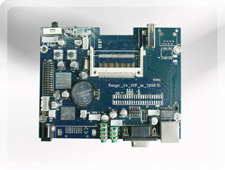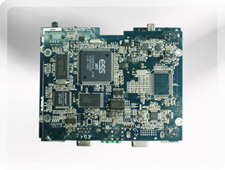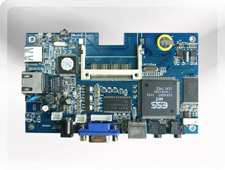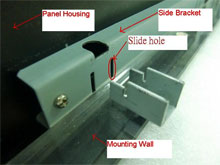| Â (1) What is a Networking Digital Signage |
| |
| A Networking Digital Signage is a collection of digital media players controlled from some central location via a Local Area Network(LAN) or a Wide Area Network(WAN / Internet). A network of media Players will generally require a Server Management software(or said Client Administration Software) to make group managements and monitor the clients status from a central point. |
| |
| The benefit of Networking Digital Signage |
 |
Labor-saving, No distance limited
Automatically update predefined content files via Lan or internet to world wide located devices,
no need manually update set by set |
 |
Instance
Advertise Spread message at next second via Lan or internet update |
 |
Precision
Through group management, We can send special content or instant message to targeted devices
located at targeted area or segment, increasing your advertisement efficiency |
|
| |
| (2) Networking Digital Signage Board Level |
| |
(2-1) ENP100 (720P/1080i) User's Manual  |
|
| |
| System |
 |
CPU: 32 bits RISC and 64 bits DSP dual processors |
 |
Network: IEEE 802.3 Ethernet single chip, Ethernet 10-baseT/100-baseT |
 |
Wireless: External wireless 802.11b/g adapter (optional) |
 |
High defination output : 720P/1080i |
 |
Content format supported : WAV / MP3 / JPEG / MPEG1/2/4 / AVI / DIVX |
 |
Output ports : DVI / YPbPr |
 |
Audio Output : Stereo 2-Ch |
 |
Built-in RTC |
 |
Storage : CF card type I & II (FAT32 file format) |
| Server Management software |
 |
User-friendly Windows based application manager |
 |
Protocols : NTP, FTP Client, HTTP Client, Web Server |
 |
Dynamic and Static IP or host name support |
 |
Auto-Start mode to download and playback automatically |
 |
Content download from local PC, FTP server or HTTP server |
 |
Continuous playback regardless of network connection |
 |
Playlist editor to manage playback sequence and schedule |
 |
Daily multiple playlist feature to allow scheduled content playback |
 |
Multiple internet time NTP access to sync with on-board RTC |
|
| |
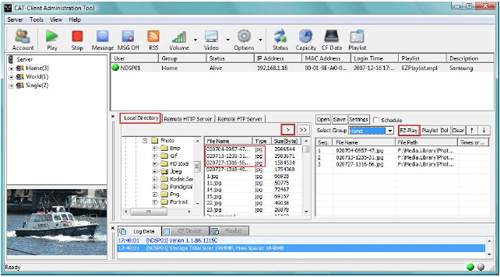 |
| |
| |
(2-2) ENP100 (480P) User's Manual  |
| |
|
| System |
 |
CPU: 32 bits RISC and 64 bits DSP dual processors |
 |
Network: IEEE 802.3 Ethernet single chip, Ethernet 10-baseT/100-baseT |
 |
Wireless: External wireless 802.11b/g adapter (optional) |
 |
High defination output : 480P, NTSC 720x480, PAL 720x576 |
 |
Content format supported : WAV / MP3 / JPEG / MPEG1/2/4 / AVI / DIVX |
 |
Output ports : VGA / S-Video / YPbPr / Composite |
 |
Audio Output : Stereo 2-Ch |
 |
Built-in RTC |
 |
Storage : CF card type I & II (FAT32 file format) |
|
| |
| (3) LCD Networking Digital Signage Player |
The networking Digital Signage board are fully setup into our wide range product lines as following.. |
| |
 |
| |
| (4) Application Diagrams |
(4-1) LAN and Internet |
| |
 |
| |
| (4-2) Wire and Wireless |
| |
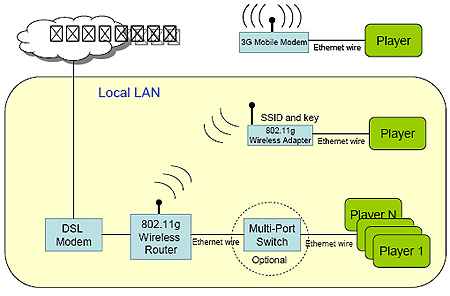 |
| |
| (4-3) Group Management |
| |
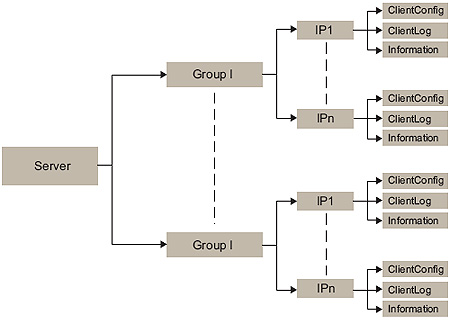 |
| |
| (4-4) Instant Message |
| |
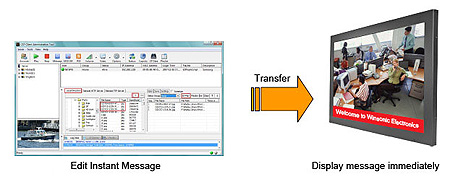 |
| |
| (4-5) GPS integrated |
| |
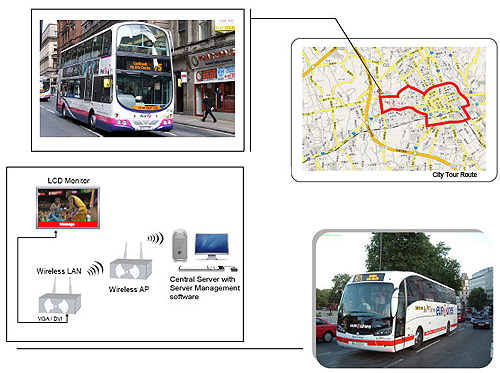 |
| |
| (4-6) 3G integrated |
| |
What is 3G / 3.5 G?
3G is the third generation of mobile phone standards and technology. 3G networks are wide area cellular telephone networks which evolved to incorporate high-speed internet access and video telephony.
3.5G(HSDPA) is a 3G mobile telephony communications protocol in the High-Speed Packed Access(HSPA) family, which allows networks based on Universal Mobile Telecommunications System(UMTS) to have higher data transfer speed and capacity. |
| |
3G/3.5G Downlink Speed Comparison
| Technology |
Max. Downlink speed |
GSM Generation |
| GSM CSD |
9.6kbit/s |
2G |
| HSCSD Downstream |
43.2kbit/s |
2G |
| GPRS Downstream |
80kbit/s |
2.5G |
| EDGE Downstream |
236.8kbit/s |
2.75G |
| EV-DO |
3.1Mbit/s |
3G |
| W-CDMA / HSDPA / UMTS |
14Mbit/s |
3.5G |
|
| |
| How does this technology work? |
| |
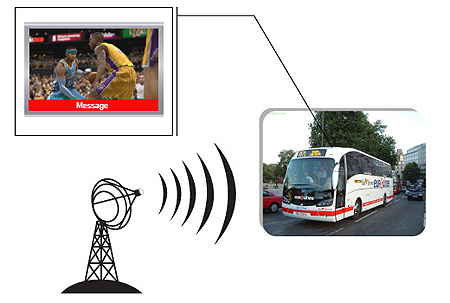 |
| |
The Digital Signage goes to totally mobile applications like: Taxi Advertising, Public Bus, Train, and Kiosks.
The high speed of 3G and 3.5 G makes this technology become very convenient and reliable to transfer
the content to the local mobile Player.
3G Support of : GPRS , CDMA , EDVO , EDGE , HSDPA , UMTS |















